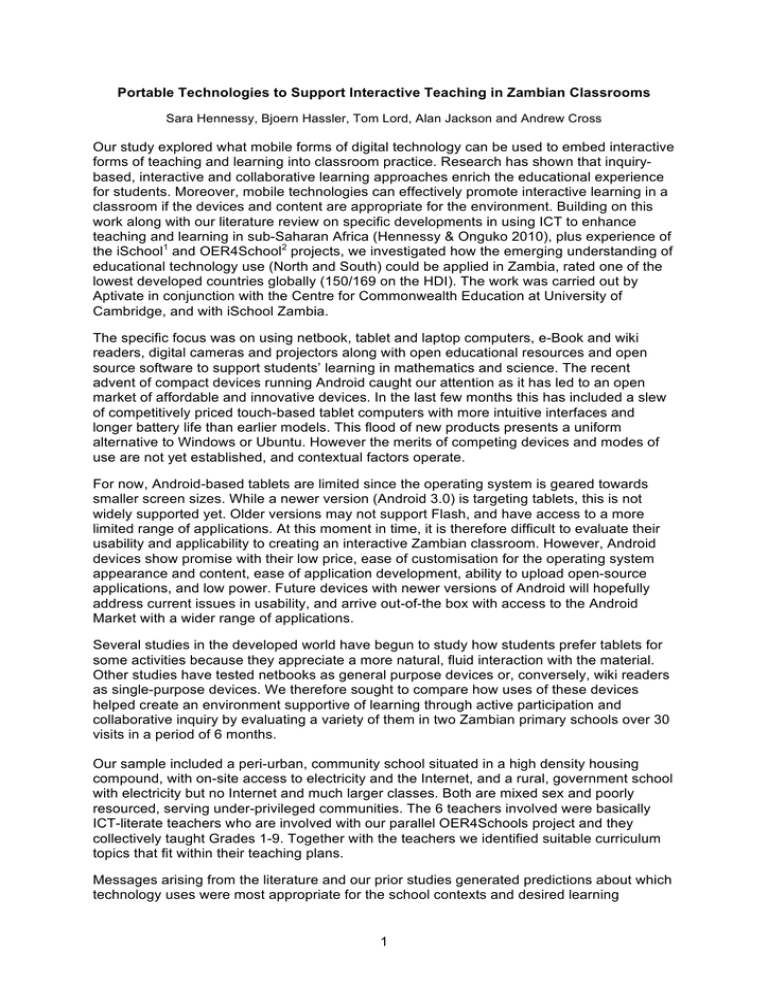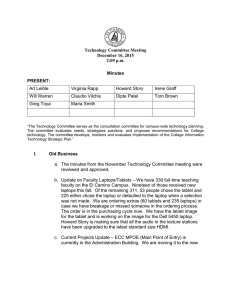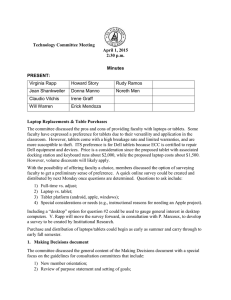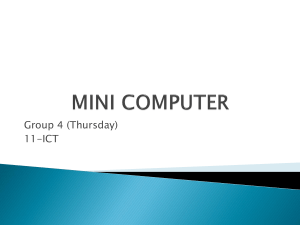1 Portable Technologies to Support Interactive Teaching in Zambian
advertisement

Portable Technologies to Support Interactive Teaching in Zambian Classrooms Sara Hennessy, Bjoern Hassler, Tom Lord, Alan Jackson and Andrew Cross Our study explored what mobile forms of digital technology can be used to embed interactive forms of teaching and learning into classroom practice. Research has shown that inquirybased, interactive and collaborative learning approaches enrich the educational experience for students. Moreover, mobile technologies can effectively promote interactive learning in a classroom if the devices and content are appropriate for the environment. Building on this work along with our literature review on specific developments in using ICT to enhance teaching and learning in sub-Saharan Africa (Hennessy & Onguko 2010), plus experience of the iSchool1 and OER4School2 projects, we investigated how the emerging understanding of educational technology use (North and South) could be applied in Zambia, rated one of the lowest developed countries globally (150/169 on the HDI). The work was carried out by Aptivate in conjunction with the Centre for Commonwealth Education at University of Cambridge, and with iSchool Zambia. The specific focus was on using netbook, tablet and laptop computers, e-Book and wiki readers, digital cameras and projectors along with open educational resources and open source software to support students’ learning in mathematics and science. The recent advent of compact devices running Android caught our attention as it has led to an open market of affordable and innovative devices. In the last few months this has included a slew of competitively priced touch-based tablet computers with more intuitive interfaces and longer battery life than earlier models. This flood of new products presents a uniform alternative to Windows or Ubuntu. However the merits of competing devices and modes of use are not yet established, and contextual factors operate. For now, Android-based tablets are limited since the operating system is geared towards smaller screen sizes. While a newer version (Android 3.0) is targeting tablets, this is not widely supported yet. Older versions may not support Flash, and have access to a more limited range of applications. At this moment in time, it is therefore difficult to evaluate their usability and applicability to creating an interactive Zambian classroom. However, Android devices show promise with their low price, ease of customisation for the operating system appearance and content, ease of application development, ability to upload open-source applications, and low power. Future devices with newer versions of Android will hopefully address current issues in usability, and arrive out-of-the box with access to the Android Market with a wider range of applications. Several studies in the developed world have begun to study how students prefer tablets for some activities because they appreciate a more natural, fluid interaction with the material. Other studies have tested netbooks as general purpose devices or, conversely, wiki readers as single-purpose devices. We therefore sought to compare how uses of these devices helped create an environment supportive of learning through active participation and collaborative inquiry by evaluating a variety of them in two Zambian primary schools over 30 visits in a period of 6 months. Our sample included a peri-urban, community school situated in a high density housing compound, with on-site access to electricity and the Internet, and a rural, government school with electricity but no Internet and much larger classes. Both are mixed sex and poorly resourced, serving under-privileged communities. The 6 teachers involved were basically ICT-literate teachers who are involved with our parallel OER4Schools project and they collectively taught Grades 1-9. Together with the teachers we identified suitable curriculum topics that fit within their teaching plans. Messages arising from the literature and our prior studies generated predictions about which technology uses were most appropriate for the school contexts and desired learning 1 objectives of mathematics and science in the Zambia primary school curriculum. Referring also to published user reviews and our own examination and configuration of promising devices, we participatively procured small sets of different portable technologies emerging as most promising. Outcomes from our first round of equipment procurement and classroom trialling in which small numbers of multiple devices were tested informed the second stage procurement of slightly larger sets of two main devices, the Advent Vega tablet and the Lenovo S10-3t tablet/netbook with swivel screen. We worked with the teachers to develop lesson plans around the chosen ICTs, paying particular attention to adopting interactive learning approaches. Students typically worked in groups of two to five (with one machine) in the lessons. Various forms of qualitative data were then gathered to characterise how the chosen technologies were perceived and used in this context. These included interviews with teachers, students and head-teachers, postlesson surveys, classroom observations, and video recordings of seven lessons. Measurements of power consumption and notes on battery life and robustness were also made. The key design principles underlying the research process included: • • • • • • • Participatory approach valuing the voices of practicing teachers in the global South in articulating their needs; Alignment of project and classroom goals; Ongoing assessment throughout the intervention; Triangulation of data collection methods; Triangulation of perspectives of research team, teachers, headteachers and learners using a culturally sensitive research approach (Tillman 2006); Attention to gender; Sustainability. To encourage open-ended activities, we drew on simple games and applications used in UK and US education (in particular Scratch and Geogebra). All of these were open source and usable at low bandwidth and selected to evaluate the (technically and pedagogically) interactive potential of the devices. Analysis of the data allowed us to determine which technology-lesson combinations held up best, both logistically and pedagogically. In the most interactive lessons at least, the students found the activities very engaging on the whole. Some of the videos illustrate fluid multi-user interaction, turn taking and teamwork as students worked towards a common goal, illustrating the potential value of the mobile technologies in this context. We noted, however, that limited proficiency in English was an obstacle to participation of some pupils; group work promoted use of local language instead. Although the multi-touch tablets are an evolving technology that brings teething problems with it, in certain ways they were pedagogically more successful than the netbooks. Particularly where games could be viewed (and played) from any angle, students could collaborate 360 degrees around the device and control was “decentralised”. Tablets are limited for text or data input, and suitable onscreen keyboards or docking stations need to be considered, where a keyboard is helpful; the swivel screen models we trialled combined the advantages of both modes of use but were more costly, and are thus not a viable option at present. Distributing resources via a wifi access point proved an efficient way of getting resources to student laptops where schools had otherwise limited or no connectivity. As the teachers were getting to grips with brand-new technologies, novel learning resources, and were still in the process of developing an interactive teaching style, we inevitably had to provide a lot of support. This included suggestions for resources to use with the devices, ways of using them, questions to ask the students, etc. in addition to technical support. Our conclusion was that under these conditions some engaging and pedagogically interactive 2 lessons can take place although it is of course not guaranteed. All 6 of the teachers were extremely positive about their experiences. They asserted that uses of the mobile devices facilitated collaboration, student learning, motivation and independent working. The principals described the beneficial impacts upon teachers, learners and the community. However we also identified some barriers to successful classroom use: • • • • • • devices can be difficult to use insufficient equipment or internet access difficulty in finding suitable online resources power issues language/culture barriers time constraints The outcomes of our study included guidelines for deploying the technologies evaluated most positively regarding usability, versatility, availability, power requirements, robustness, integration with interactive teaching and support for collaborative learning. etc. For example: • • • • • • • ICTs should be procured in sets comprising a teacher laptop and student laptops, as well as provision for storage and transport. Robust and cheap netbooks (e.g. the Classmate netbook) are presently the best candidates for classroom use. Android-based tablets can support interactive, collaborative learning effectively but technically (in version 2.2) they are not yet ready (early 2011). Keyboard-based data entry in Flash games can be particularly difficult. However, devices running Android 3.0 should be reconsidered for future procurements, including an investigation of suitable onscreen keyboard or docking stations. We would not recommend mixing devices within a single class, but if more than one class set of computers was procured, it may make sense to purchase a set of netbooks (for tasks requiring a standard operating system), as well as a set of tablets. However, cost and setup/maintenance issues need to be considered. Teacher and student laptops need to be configured well so that effort expended in lesson preparation is not prohibitive. Resource sharing with student laptops needs to be considered; local wireless networks can be deployed effectively to achieve this. Non-digital resources, such as mini blackboards, add significant value and cheaply. Continuing professional development opportunities are essential for teachers to become familiar with the mobile technologies and to make creative use of them. Hennessy, S., & Onguko, B. (Eds.). (2010). Developing use of ICT to enhance teaching and learning in East African schools: a review of the literature. Cambridge and Dar es Salaam: Faculty of Education, University of Cambridge and Aga Khan University Institute for Educational Development Eastern Africa. Tillman, L.C.(2006). Researching and writing from an African-American perspective: reflective notes on three research studies, International Journal of Qualitative Studies in Education, 19: 3, 265-287. DOI: 10.1080/09518390600696513. 1 2 http://www.ischool.zm http://www.educ.cam.ac.uk/centres/cce/initiatives/projects/ictzambia/ 3




